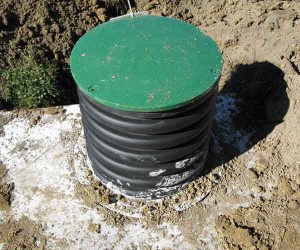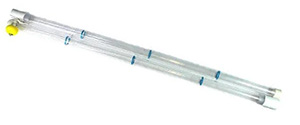How to Install Your Own Septic System
“Can I install my own Septic system?”
The phrase “I built this house” means something completely different here in rural Indiana. No, it doesn’t mean you paid someone to build your home. Instead, it means you know about floor joists and the inner workings of a nail gun. In Goshen, when things break, instead of visiting the yellow pages, people usually visit the local hardware store for the necessary parts and tools.
The same attitude exists regarding septic system installation. People often ask me if they can install their own septic system (usually a replacement system). After a wary pause, I give a thoughtful and well-articulated gem of advice.
Unless you are skilled and familiar with heavy machinery, I suggest you contact a local professional to get the job done right. However, if you regularly operate a backhoe or excavator (or have a friend or relative who does) this might just be your chance to adopt a colorful nickname like “Toilet Joe” or “Smelly Ray” and temporarily join the brotherhood.
A word about safety:
Installing a septic system involves, first and foremost, keeping yourself and the people around you safe. Sure, that mini excavator at the Rent-It Center looks twice as fun as your latest and greatest Wii game, but it can disable or kill in seconds. This is one of many reasons why I suggest you don’t install your own system. These thing are better left up to the professionals. Also, IT IS VITAL THAT YOU HAVE ALL UTILITIES PROPERLY MARKED BEFORE YOU DO ANY DIGGING! call 811 (or call other utility marking services in your area) to get all utilities marked. These services are almost always free and it is the law. You will be held responsible for hitting any utilities, so get them marked and avoid them. Also note that these utility marking companies will not usually mark private utility lines. See the 811 website for details.
Gravity is a miraculous force. It keeps our feet firmly on the ground but also has some annoying traits. Just as gravity pulls your belly closer to the ground every year, it also acts on the soil in your newly dug trench’s sidewall, causing frustrating cave-ins. This is maddening, but more importantly, it’s very dangerous. Soil is really heavy. If your leg happens to be in the way, it’s likely to get broken. The sandier the soil and the deeper your dig the more prevalent and dangerous cave-ins becomes. So be careful out there!
Some septic systems, such as sand mounds, can be complicated installations even for seasoned excavator. Again, if your backyard requires a mound system, the installation is almost certainly better left to an experienced installer.
Now, let’s assume that you are going to attempt the installation of a typical gravity flow septic system. Let’s say that you’ve decided that installing your own septic system is a good fit for you because of your membership in a Hoosier Militia or the fact that your brother-in-law “borrowed” a backhoe for the weekend from the State Highway Department.
If you live in Indiana, The first thing you will need to do is reference my Indiana Septic System Procedure Guide. The main steps are:
1 – The On-site Evaluation
2 – Getting the System Requirements
3 – Get a Design
4 – Permitting (Don’t install anything unless you have the required permits)
5- System Installation and Inspection
Once you have your septic system requirements, it will be time to get a septic design (septic plan).
An installation mistake like installing trenches too deep, using the wrong pipe schedule or slope, can be costly and take lots of time to correct. The last thing you want is that same local health department inspector, the one who tried to talk you out of installing your own system, to say “I told you so!”
Carefully following a well through-out septic design will eliminate installation headaches. My septic designs are often used by do-it-yourselfers to successfully install their own systems. They are drawn to scale on 18″ x 24″ paper, marked on-site and are backed up by telephone support six days a week to ensure smooth and successful installations.
The design also allows you to sail through the permitting/plan submittal process (where others can get hung up for weeks revising plans).
Read more about my design and services HERE.
In addition to a backhoe or small track hoe (with a 2-3′ wide bucket), you will also need some smaller tools and equipment.
The following can be found at your local hardware store or rented nearby:
Shovel
Laser Level
Hand Level (for Box leveling and pipes)
PVC saw
PVC pipe primer and glue
Measuring tape (a 100′ tape is convenient)
Rubber Mallet
Gloves
Supplies for your installation may include the following. Most of these items can be purchased from your local concrete precaster (septic tank manufacturer):
- Septic Tank (delivered to your site)
- PVC pipe (gravity sewer, effluent sewer and perforated pipe)
- Plastic chambers for the trenches (if you choose to use chambers)
- If you are using stone trenches, you will need some geo-textile fabric to cover it
Be sure to check with your local health department to find out what inspections are needed and when they can do them. Know what expectations the health department has for the inspection. Do all the newly installed trenches need to be left open for inspection or is it okay to partially cover them? Does all piping need to be exposed with ASTM ratings readable or is it okay to cover the pipes?
If it’s possible, be present when the health department does the inspection. Holding a very cute puppy is likely to help you get an approval slip from the health department.
Some common trench system inspection violations to avoid:
-
- Distribution Box is not level
- Piping is not primed and or glued
- Wrong type (schedule, ASTM-D number) of piping
- Septic Tank not set level
- Tank inlet and outlet baffles are not installed or are not the proper length
- Distribution Box inlet baffle or tee not installed or not glued
- Septic tank riser not installed
- Septic Tank riser improperly sealed or not tall enough
- Trenches are too deep (Ouch! Follow your design and this will not happen)
- Piping has improper slopes or even goes uphill!
- Improper or inadequate seals at septic tank or distribution box
- Pipes not correctly bedded (install according to manufacturer’s recommendations)
Once your system has been given a passing inspection it will be time to cover it.
Be sure to back-fill around chambers as recommended by the chamber manufacturer. A sloppy back-filling job will result in unsightly settling in your yard and an angry spouse.
Your job is not finished until your establish a grass cover. Topping off your system with a dark loamy soil will help the new grass to thrive. Some folks prefer hydro-seeding. Though more expensive, it will eliminate labor for your and guarantee some fast growing grass.
Now that you have a “new” septic system, be sure to read about how to take care of it!
Related: How to care for your septic system
Should you ever pump your septic tank? The answer is yes!


